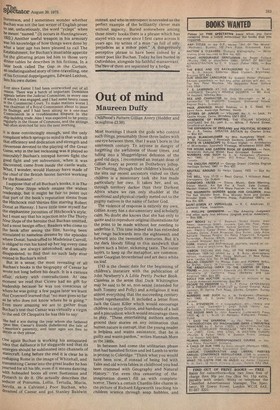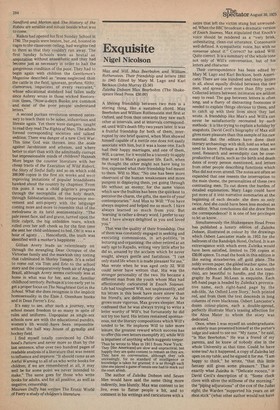Out of mind
Maureen Duffy
Childhood's Pattern Gillian Avery (Hodder and Stoughton £3.50).
Most mornings I thank the gods who control such things, presumably those three ladies with one eye between them, that I wasn't born in the nineteenth century. To anyone in danger of forgetting the awfulness of those times, and falling into a Muggeridgean delusion of the good old days, I recommend an instant dose of Gillian Avery as potent as Dotheboys jollop. The charting, through their children's books, of the sins our recent ancestors visited on their children is a missionary task she has made particularly her own. It takes her, and us, through territory darker than their Darkest Africa where we can only shudder at the emotional and physical cruelty meted out to the pygmy natives in the name of father God.
The violence of response is entirely my own. Gillian Avery has a documentary and scholarly calm. No doubt she knows that she has only to quote and to reproduce original illustrations for the point to be made without her needing to underline it. This time indeed she has extended her range backwards into the eighteenth and forward into the twentieth centuries. But it's the dark bloody filling to this sandwich that leaves such a bitter, sickening taste. The outer layers, to keep up the metaphor, are commonsense Georgian brownbread and art deco white tin loaf.
1743 is the classic date for the beginning of children's literature with the publication of John Newbeny's A Little Pretty Pocket Book. Classless in the sense that Dick Whittington may be said to be so, non-sexist (intended for both Tommy and Polly) and a-religious it was almost everything that the succeeding century found reprehensible. It included a letter from Jack the Giant Killer which would encourage children to enjoy fiction, and handouts of a ball and a pincushion which would encourage them to play. "These entertaining authors seldom ground their stories on any intimation that human nature is corrupt; that the young reader is helpless and wants assistance; that he is guilty and wants pardon," writes Hannah More in the 1800s.
In between had come the utilitarian phase that had banished fiction and led Lamb to write in protest to Coleridge: "Think what you would
have been now, if instead of being fed with
Tales and old wives fables in childhood you had been crammed with Geography and Natural History." Yet even this censoring of the imagination doesn't fill us with complete horror. There's a certain Chardin-like charm in the picture of Richard Edgeworth teaching his children science through soap bubbles, and
Sandford and Merton and The History of the Robins are sensible and robust beside what was to come.
Raikes had opened his first Sunday School in 1780. The pupils were beaten, bur.,ed, hoisted in cages to the classroom ceiling, had weights tied to them so that they couldn't run away. The first Sunday Schools were as brutal as amputation without anaesthetic and they had become just as necessary in order to halt the gangrenous condition of the poor. They had to begin again with children the Gentlemen's Magazine described as "more neglected than the cattle in the field; ignorant, profane. filthy, clamorous, impatient of every restraint," whose educational standard had fallen sadly since Aubrey wrote in those wicked Restoration times, "Now-a-days Books are common and most of the poor people understand letters."
A second puritan revolution seemed necessary to teach them to be sober, industrious and literate again. Yet there were dangers: taught to read they read The Rights of Man. The adults formed corresponding societies and talked sedition. There was danger of a new Civil War. This time God was thrown into the scale against Jacobinism and atheism, and where better to start than with the admittedly corrupt but impressionable minds of children? Hannah More began the counter literature with her cheap tracts of the Execution of Wild Robert, the Story of Sinful Sally and so on which sold 300,000 copies in the first six weeks and were improving imitations of popular broadsheets hawked about the country by chapmen. From this point it was a child pilgrim's progress through the necrophilia of the holy death, through Sabbatarianism, the temperance movement and anti-popery with the language coming more and more to resemble that of the melodrama in its lurid sentimentality. "The pale sweet face, sad and grave, turned upon the little culprit, the big unbidden tears, which rolled over her soft cheek as for the first time she sent her child unblessed to bed. Oh! it was a hour of agony . . . Henceforth, the truth was identified with a mother's happiness ...."
Gillian Avery leads us relentlessly on through the strangling Dear Octopus of the Victorian family and the mawkish tiny totting that culminated in Shirley Temple. It's a relief to come out via Tom and Eric to the school story and the comparatively fresh air of Angela Brazil, although Avery seems curiously less at home in what was for her, and me, familiar childhood territoey. Perhaps it's too early yet to get a proper focus on The Naughtiest Girl in the School. What she does recognise is the implicit homosexuality in the Elsie J. Oxenham books and in Dean Ferrer's Eric.
It's easy to see, after such a journey, way school meant freedom to so many in spite of rules and uniforms. Unpopular as single-sex schools now are with the educational pundits, women's lib would have been impossible without the half way house of gymslip and hockey field.
I find myself totally convinced by Childhood's Pattern and never more so than by the last sentence, after over two hundred pages of readable analysis of a literature that was meant to influence and improve: "It should come as an Awful Warning to all of us who write books for children; if we are remembered at all, it may well be for some point we never intended to make." The same goes for those who write books for adults, and for all positive, as well as negative, censorship.
Maureen Duffy has written The Erotic World of Faery a study of children's literature.



































 Previous page
Previous page